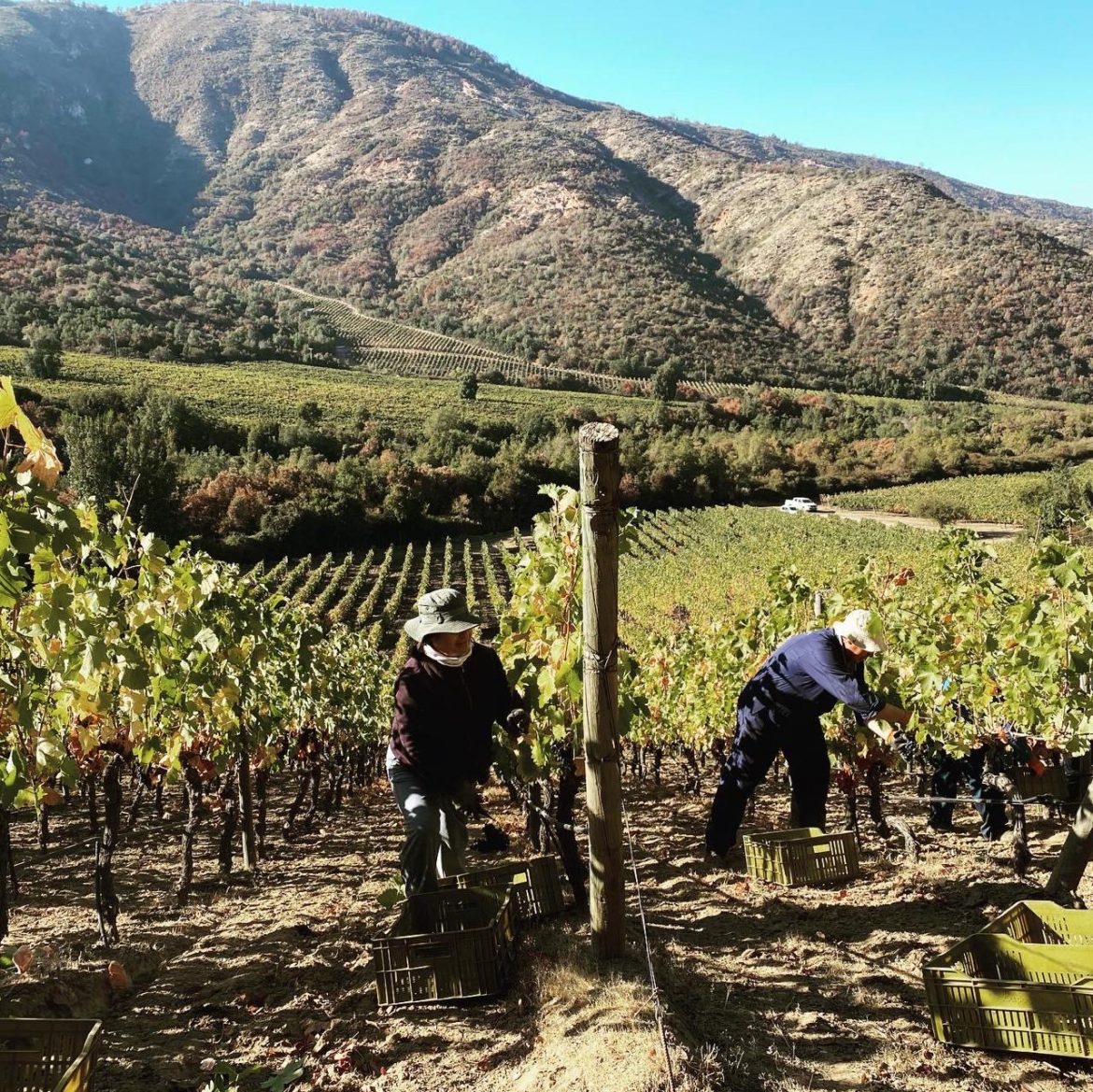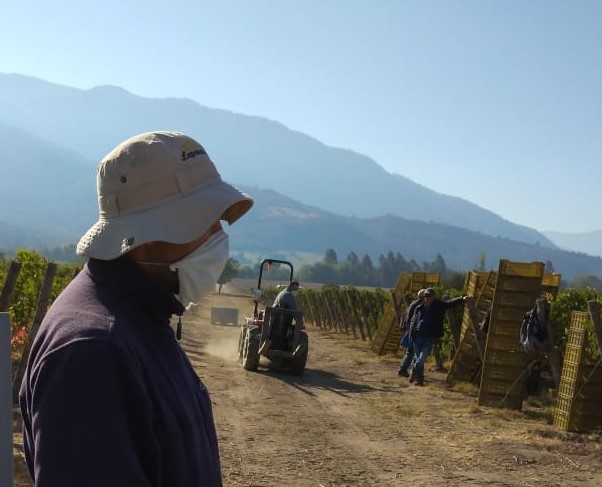The Chile Vintage 2020 will be a harvest no-one will ever forget, not only due to an extremely early and hot season that was made especially challenging because of the ongoing drought, but also because it was impacted by the Coronavirus pandemic that broke out towards the end of harvest.
“This vintage is definitely one we will all remember,” says Emily Faulconer of Viña Carmen, who makes wine with grapes from all over Chile. “To start, it was marked by the very serious drought and a warmer winter than usual, which meant much earlier flowering in most vineyards. A hot year like this can be very challenging in terms of organisation, as the window for harvest is much smaller and more complex and you are harvesting red and white varieties at the same time. But in this case, it was a blessing in disguise – although we didn’t know at the time that we were about to face the Coronavirus pandemic – because it meant that most of our harvest was done by the time quarantine started.”
Harvest dates were brought forward by between a week and month in some valleys, meaning that most producers had brought in the vast majority of their grapes by late March when curfew and quarantine restrictions came in.
The earlier harvest was also aided by the decreased yields; there was a widespread reduction of between 20% and 30% caused by a combination of drought conditions, hot temperatures and significant losses from a bout of ferocious frost events in September, October and November — with several nights dropping below 0˚C each month in many regions of the Central Valley.
“As they say in the countryside, ‘dry winters bring frosts’, and we were hit with three major frost periods,” says Eduardo Jordán, winemaker at Miguel Torres, who makes wine from many of Chile’s wine regions. “This was also an extremely dry vintage — with a big deficit in rain across almost all of Chile. In Curicó we had 500 mm less rain than normal; and in La Serena, for example, where we usually get 78 mm of rain, only 12 mm of rain fell! This year in Maipo the hills, which are normally green and covered in vegetation were completely grey, as the plants couldn’t survive the drought and dried up. It’s unbelievable how year by year we are seeing how global warming is reducing the rains here in the south.”
Chile’s drought is becoming a significant concern. It has lasted over a decade and is considered one of the most extreme in living memory. In Curicó, for example, 2019 was the driest year ever on record, with a rainwater deficit of over 75%. In a survey by the Chilean Association of Winemakers, 80% of the wineries and producers interviewed reported that the drought had caused a severe effect on their vintage this year.
Working with drought-resistant varieties is probably going to become an increased priority in Chile from now on, and some winemakers have noted that they are the varieties that performed best this year. “This year is going to be a very good year for Mediterranean varieties, including Syrah, Carignan and Monastrell, as well as Semillon,” says Christian Sepúlveda, winemaker at Bouchon Family Wines in Maule. “I have seen these vigorous varieties do very well despite the lack of water and the consistently high temperatures of this vintage. Whereas Cabernet Sauvignon and Merlot have suffered more from the lack of water and high temperatures, so we had to be particularly careful about our harvest dates to avoid any dehydration and use delicate extraction techniques during the winemaking.”
Quality despite diminished quantity: Chile Vintage 2020
“This will probably go down in history as the ‘strangest’ harvest!” reported Felipe Müller, winemaker at Tabalí in Limarí valley. “First of all because it was a really early vintage, secondly because the Cabernet Sauvignon and Carmenere had very low natural yields (down 15% and 30% respectively), thirdly because the warm vintages aren’t normally the best but this year the wines have spectacular quality, and last but not least, it was strange because of the impact of Coronavirus during the vintage.”
Although the heat, low yield and pressure of a pandemic were the perfect storm for a difficult vintage, Felipe says he was surprised at the quality achieved across the board: “The quality of the 2020 vintage is excellent in all varieties in Limarí, especially as we are so close to the coast that we have a very stable climate in terms of temperatures but also because we typically harvest earlier. Our earlier harvest has allowed us to produce wines of great quality: mineral, fresh, with tension and potential to age.”
Balance was also still achieved in many other regions, despite the temperature spikes. “The 2020 vintage was completely atypical,” continues Eduardo Jordán of Miguel Torres. “Even though it was really hot, the acidity levels were still relatively high… Normally I’ll harvest at 13.5% alcohol, but this year I actually had to wait longer as the acidity was still sky-high! I think the high acidity could be due to the lack of water at a certain period during ripening. The Chardonnay from Limari this year, for example, has excellent concentration and great acidity; and Malbec for me is one of the best varieties this year — fresh with soft tannins.”
Certain varieties, such as Merlot, which generally requires a good amount of water, and the warmer wine regions suffered more from the heat and drought. The results for Cabernet Sauvignon, Chile’s main grape variety, depended very much on the particular site.
“In Alto Jahuel, I’ve seen excellent results for our Cabernet Sauvignon — with great concentration and where the stressful conditions permitted us to harvest ripe but fresh fruit,” explains Emily Faulconer of Viña Carmen, speaking about their main vineyard. “For me we have good balance between moderate alcohol (especially because of our earlier harvests) and very good acidity. The majority of our fermentations finished with a pH of around 3.6 and acidity at around 5.5g/l tartaric. And I’ve tasted many blocks that have a very floral profile with violets and rose petals, which I love in Cabernet Sauvignon.”
Santa Rita Head Winemaker Sebastian Labbe is also a fan of the Cabernet this year, and of Carmenere: “2020 was a great year for Cabernet Sauvignon, the high summer temperatures ensured a short and even veraison. There is a tremendous natural balance between the alcohol and the acidity, which ensures a long life for the wines of this vintage. The 2020 vintage offered remarkable conditions for Carmenere in Apalta, in the Colchagua Valley, with good levels of ripeness and an excellent balance between alcohol and acidity. This balance does not occur every year, so we truly celebrate vintages like this one”.
2020 Chile Vintage Report by Valley
Elqui harvest report 2020
A warm and dry year with some difficulties in terms of water access. Pisco production is expected to be down by a fifth.
Limarí harvest report 2020
Warm and dry year with no reports of frost. However water shortages caused a significant reduction in yields (up to 40% in some areas).
Choapa vintage report 2020
A really hot vintage, which saw lots of dehydrated grapes and a heat wave that caused losses of up to 50% in some areas.
Aconcagua vintage report 2020
Warm and early year, with no reports of frost. Veraison was 15 days early in most regions and a hot summer meant that the harvest was between 15 and 20 days earlier than normal too. Production is down by 10% to 20% compared to last year due to lower water availability.
San Antonio & Casablanca harvest report 2020
A very dry winter, warm spring and very hot summer. September and October frosts affected most regions within San Antonio and Casablanca, and producers reported losses of up to 30% (and even greater losses in some cases). Temperatures in Leyda were recorded as low as -5°C on 2 October. The varieties worst affected by the frosts were Chardonnay, followed by Sauvignon Blanc and Pinot Noir.
Lower yields and a hot summer caused much earlier harvest dates.
Maipo vintage report 2020
Early, dry and hot vintage. Some frosts were reported in Pirque and Melipilla, in particular, although damage was mostly in early-budding varieties Chardonnay, Sauvignon Blanc and Pinot Noir, which are much less common in Maipo. Flowering was up to two weeks early, and the harvest was two to three weeks early due to the hot weather. Restricted water supplies also caused a drop in production of up to a fifth.
Cachapoal vintage report 2020
A hot, dry vintage that came at least two weeks early. Chardonnay and Sauvignon Blanc were affected by the frosts (with production down by up to 30%) and Merlot was also affected to a lesser extent (with a 10% drop in yield). Drought also significantly hampered yields this year, reducing the production of Chardonnay and Cabernet Sauvignon and several producers abandoned certain sectors of their vineyards this year for lack of water.
Colchagua vintage report 2020
A very dry and hot year with barely any rain, which caused significant drought problems. Both flowering and harvest were more than two weeks early in most sectors, and frosts affected some vineyards quite severely. The combination of drought and frost means some producers are reporting major losses of over a third of their normal production levels.
Curicó harvest report 2020
Dry, hot and early vintage which saw some record high temperatures. Water shortages and drought caused significant problems for producers, especially in Sagrada Familia and Romeral. Production was also down because of frosts (which mainly affected Chardonnay, Sauvignon Blanc, Syrah and Cabernet Sauvignon), and in general producers are reporting a drop in production of between 10% and 30%.
Maule vintage report 2020
Dry and hot year where the drought was particularly acute for dry-farmed regions which received very little rain this year. Flowering was up to 20 days early in some sectors, heat waves were an issue for many vineyards and some sectors were also affected by frost, resulting in production being down by between 10% and 25%.
Biobío & Itata vintage report 2020
A much drier year than normal and a warm spring brought flowering forward by up to 20 days in some regions. Frost in November also caused significant losses in some parts of Itata in particular. Dry-farmed regions were hit hard by the lack of rain, and there was also insufficient water for irrigation, causing a loss in production of up to a third.
Viña Carmen‘s team share their perspectives of Chile 2020 vintage in this video:
Read about all of the recent Chile vintage reports online:
Guide to Chilean vintages
Photos by winemaker Andrea Leon from Lapostolle in Apalta

